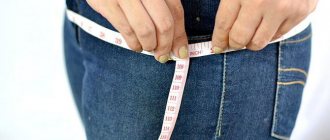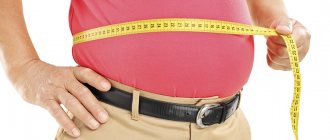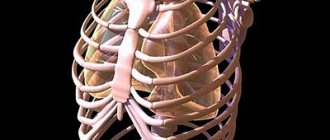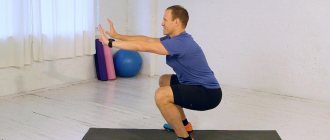The beauty of the male body largely depends not only on the relief and volume of muscles. To achieve the ideal, it is much more important to maintain the proportionality of all its parts: the volume of the chest with the pelvis, and so on. Differences in age and race of a person have proportional significance. Let's figure out what the ideal proportions of a man's body are. This will be equally useful for both professional athletes and people who strive for excellence.
Proportions in men's bodybuilding
The most desirable body type is the “inverted triangle” - wide shoulders and a narrow waist. Therefore, most men strive for precisely these proportions, completely forgetting about other parameters.
For example, athletes with a massive upper body and matchstick-thin legs look pretty funny. Another problem that often occurs among beginners is that the “bottom” is ahead of the “top” in development, which is also a disproportion. In both cases, serious correction of the training program is necessary.
Many systems have been developed for calculating the “ideal” anthropometric indicators of male bodybuilders. Let's look at the simplest method. First you need to measure your chest circumference with a centimeter. Let's assume that this parameter is 100 cm and calculate the remaining values.
| Pelvis | 90% of chest volume | = 90 cm |
| Waist | 75% of chest volume | = 75 cm |
| Hip | 60% of pelvic circumference | = 54 cm |
| Shin | 60% of thigh circumference | = 32.4 cm |
| Forearm | 30% of chest volume | = 30 cm |
| Neck | 38% of chest volume | = 38 cm |
You can also use the table compiled by the legendary Canadian-American coach, founder of the Mr. Olympia competition and founder of the International Bodybuilding Federation - Joe Weider. To determine the proportions, it is necessary to calculate the individual coefficient. To do this, divide your weight (kg) by height (cm) and compare the resulting value with the data below.
By measuring your own proportions and comparing them with any of the tables above, you can determine the “lagging” parts of the body. Based on the obtained values, it is recommended to build a training plan.
Mass and circumference
It is noteworthy that measuring the volume of the hips and chest can provide more reliable information about progress in training than daily weighings. This happens because muscle mass, which increases with exercise, weighs more than fat tissue. There are many beneficial changes that can occur in the body that the measurement of kilograms will not confirm.
Almost everyone, without exception, prefers tall height in men. It is often stated that 180 cm is the minimum. The bigger, the better. Meanwhile, the average height for a European is only (or maybe for now?) 177.8 cm. Theoretically, this is not the worst result, but given the ever-increasing height of a woman, it is difficult to admire this.
We suggest you read: Gel pads for the skin around the eyes - WomanWiki
It doesn't take an expert to spot the obvious trend. From year to year, men gain weight. Already today the average is 83.5 kg. Of course, it all depends on height, proportions and the ratio of fat tissue to muscle tissue, but the average person is most likely not a bodybuilder. One might even conclude that the average man would do well to take steps to lose weight.
These trends have a direct impact on changes in chest circumference assessment. What used to be the average chest circumference is no longer so. Therefore, you should not use outdated data.
The times we live in have created their own idea of the ideal male silhouette. The ideal male body can be described using three adjectives: muscular, proportional, tall. And chest circumference plays a big role in this. Ideally, it should be at least 100 cm.
Female proportions
Modern girls strive to look as slim as possible. Therefore, classic bodybuilding is not very popular among the fair sex. But body fitness has become widespread - a discipline aimed at the harmonious development of the female body, without gaining extreme muscle mass.
In this sport there are no clear proportions and weight categories, as in men's bodybuilding. Athletes are judged strictly visually. The only gradation of participants is height (158 cm/163 cm/168 cm/over 168 cm).
But even such simplified assessment conditions require long-term, high-quality preparation from applicants. For girls who have never been involved in bodybuilding, we recommend paying attention to the “fitness bikini”.
The main indicators in this discipline are attractive appearance, slender physique, and the absence of pronounced muscle relief. Therefore, beginner athletes can achieve competitive shape in a short period of time.
Note that a fitness bikini requires the presence of a “base”. That is, a girl’s figure by nature must meet certain standards: long legs, low subcutaneous fat content, the correct ratio of chest, waist, and hip volumes. Training and diet should only slightly adjust the existing shape. Therefore, unfortunately, this discipline is not suitable for everyone. But those girls who decide to professionally engage in fitness bikini should take into account the following principles:
- Maximum femininity. Strongly developed latissimus dorsi muscles, prominent deltoids, angular quadriceps - all these are indicators of an athlete-bodybuilder. The main task of bikini girls is to create a slender, toned silhouette without clearly defined muscles. Therefore, choose your mentor wisely. It is best to contact female trainers who have competed directly in the “fitness bikini” category.
- Lack of abs on the stomach. In bikini athletes, the abdominal muscles should not stand out too much. Of course, this muscle requires working out, but without creating a clear relief. Otherwise, the girl may “go beyond” the category and not get into the competition. Therefore, we recommend that you focus on static planks and vacuum, and it is best to avoid power crunches with weights.
- Long legs. Since fitness bikinis are judged on overall proportions, the first thing judges look at is the lower limbs. They should be longer than the upper body. Only with such data can a girl achieve positive results. Athletes with short legs, even on large platforms, will always lose. Girls need to take this point into account if they are going to professionally engage in bikini fitness.
- Feminine breasts. In this sport, this is an important part of the body, as it complements the overall image. Unfortunately, exercises will not work to increase breast size. Therefore, if you do not have naturally attractive shapes, but want to build a sports career in a “bikini,” perhaps you should think about enlargement surgery (we are only voicing the expected obstacles and are not encouraging anyone to go under the surgeon’s knife).
- Worked buttocks. This part of the body is one of the main ones when assessed by judges. You can have long legs, beautiful breasts, a flat stomach, but if the gluteal muscles look undeveloped, you can forget about winning places. Therefore, every “bikinist” who wants to achieve high results must perform squats, lunges and leg presses. For cardio, it is best to use running or walking on a stepper.
If you don’t want to perform on the podium, but are simply trying to get closer to the “90–60–90” standard, general strengthening fitness, aerobics, dancing, running training, active game disciplines, cycling, etc. are best suited for you.
At the same time, do not forget about a balanced diet. The combination of aerobic training and a low-carb diet will help you quickly get rid of subcutaneous fat and tighten your body muscles. The main thing is to exercise regularly.
Taking measurements
The procedure will require a measuring tape. If you don’t have it at hand, you can use a lace and a school ruler. Let's look at the main parameters and where to measure them:
- Chest circumference. Stand up straight, straighten your back. Throw a tape measure over your back. The measuring tape should go along the bottom of the shoulder blades, the latissimus muscles and the pectoral nipples. The tension is light, without squeezing the skin. The measurement is taken while exhaling.
- Hip volume. Stand up straight, lift one leg onto your toes. To measure the circumference of your hips, you need to press the tape measure in the widest part of them (the upper third, just below the buttocks). Tighten your quadriceps, pull the band slightly taut, and record the value. Then measure the thigh muscles on the other leg.
- Calf circumference. Straighten up, lift one leg onto your toes. Press the measuring centimeter to the widest part of the calf muscle, bring the end together with the tape and record the parameter. Repeat with the other leg.
- Shoulder circumference. It is necessary to clarify this issue. People who are far from sports mistakenly call the shoulder the main joint of the arm and the muscles covering it. In fact, the shoulder is the entire upper part of the limb from the edge of the collarbone to the elbow. Therefore, in order to correctly measure your shoulders, you need to lower your arms freely, and then cover the biceps muscles in the middle with a centimeter.
- Forearm circumference. To begin, bend your elbow at a right angle and clench your fingers into a fist. To measure your forearm, you need to place the tape at its widest point (3-4 cm below the elbow joint).
- Bicep circumference. Stand up, raise your shoulder until it is parallel to the floor, bend your arm and tense your biceps muscle. Throw a centimeter at the top point of the biceps, take a measurement and repeat with the other arm.
- Waist circumference. Straighten up, straighten your back. To measure your waist, place the tape measure at the narrowest part of your body. As a rule, this place is located just above the navel. Exhale, but do not suck in your stomach. Record the value.
- Neck circumference. Measure this parameter under the thyroid cartilage of the larynx.
- Pelvic girth. To determine this indicator, press the tape to the middle of the gluteal muscles and to the upper protruding parts of the thigh bones.
In addition to the size of the biceps and forearms, some athletes determine the thickness of the wrists. But this indicator serves not to track results, but to identify a predisposition to gain muscle mass.
Previously, many trainers predicted the success of a particular athlete in bodybuilding based on the measurement of the carpal bones. However, there is no scientific evidence for such a correlation.
Selection of men's clothing based on information on tags and tags.
Introduction.
There is an opinion that it is much easier for a man to choose clothes for himself than for a woman. This is partly true, since men's clothing is generally more modest and less varied. But it is precisely because of this circumstance that the problem of choosing the correct size of a suit, trousers or shirt comes to the fore. As one popular film said: “The main thing is that the suit fits.” At first glance, the problem is not particularly difficult to solve, since there is a “standard” system of sizes for men’s clothing, based on several
the main parameters of the male body: height, neck circumference, chest circumference, waist circumference, hip circumference and waist height. However, the figure of many men very often differs from the “standard” one, for example, when the shoulder girdle turns out to be significantly wider and more voluminous than the hip girdle. In this case, it is necessary to clarify the sizes of the “top” and “bottom” using additional individual measurements. In addition, the height and weight of many men differs quite significantly from the “standard” ones, which also entails the need to clarify the sizes. An additional complexity when choosing clothing in general and its elements separately when purchasing in online stores is created by the fact that different countries have adopted different systems for marking clothing sizes, applied to hanging tags and sewn-in fabric labels, as well as to clothing labels. for children. In this article we will try to systematize information about determining the sizes of men's clothing so that this task will never cause you difficulties again. Up
Taking measurements.
To measure body parameters, you will need a measuring tape and an assistant who will take measurements (taking measurements yourself is fraught with errors that can lead to significant errors when determining clothing sizes). During measurements, the man should stand straight, without tensing his muscles or drawing in his stomach. Girth measurements should be taken so that the tape fits snugly to the body, but is not overly stretched. It is recommended to add 1-2 centimeters to the measurement results. It is recommended to take measurements in thin clothing or underwear.
Neck circumference - Wrap a measuring tape around your neck about two centimeters above where the neck meets the shoulders (for many men, this is the bottom of the Adam's apple). A “non-round” result should be rounded up to the nearest whole number of centimeters. Chest circumference - a measuring tape runs along the most protruding points of the chest, along the sides - under the armpits. Waist circumference - measured strictly horizontally at the level of the narrowest point of the waist. Hip circumference - a measuring tape runs horizontally along the most protruding places of the buttocks. Height - it is best to measure height by leaning your back and the back of your head against the wall, on which a mark is made at the level of the top of the head, after which the distance from this mark to the floor is measured. Waist height is the distance from the waist line to the floor. Up
Standard clothing sizes.
“Standard” refers to the body proportions typical of most modern men. It is according to “standard” patterns that mass production of men’s clothing is organized. In Russia, the basis for measuring men's clothing is the half-chest circumference, expressed in centimeters. It is this indicator that appears on hanging labels and sewn-in fabric labels. In other words, if a man’s chest circumference is 100 cm, then his clothing size is 50. Standard heights are considered to be from 148 to 204 cm and waist height from 98 to 126 cm. In addition to size, the labels indicate height, which is divided into the following ranges.
Correspondence between actual height and height indicated on the label
| Height on label | 152 | 160 | 168 | 176 | 184 | 192 | 200 |
| Real growth interval | 148-156 | 156-164 | 164-172 | 172-180 | 180-188 | 188-196 | 196-204 |
If a sew-in label usually indicates a two-digit clothing size (48, 50, 52, etc.), then three parameters are often printed on a hanging tag - height, chest girth and hip girth (for example, 176-95-100). Up
Standard trouser sizes.
To determine the size of men's trousers, the same measurements are used as when determining the sizes of all other types of clothing - height, as well as waist and hip circumferences. The height scale for trousers has a slightly smaller step - 4 cm instead of eight, like other clothes.
Height indicated on trousers
| Height on the tag | 156 | 160 | 164 | 168 | 172 | 176 |
| Real growth | 154-158 | 158-162 | 162-166 | 166-170 | 170-174 | 174-178 |
| Height on the tag | 180 | 184 | 188 | 192 | 196 | 200 |
| Real growth | 178-182 | 182-186 | 186-190 | 190-194 | 194-198 | 198-202 |
Some domestic manufacturers of trousers can place their size on labels and tags in the form of a fraction, the numerator of which is half-waist circumference, and the denominator is height (for example, 54/176). The above tables for determining trouser sizes do not apply to determining jeans sizes, which is based on measuring the waist circumference and leg length along the inner surface. You can read about the labeling of jeans in the article “What does the label on jeans say?” Up
Standard shirt sizes.
The main factor determining the size of a shirt is the circumference of the neck, expressed in centimeters. This is what is indicated on the sewn-in fabric label placed on the inside of the collar. However, to ensure that the collar of the shirt does not turn out to be too tight, it is recommended to add 1-2 cm to the measurement results, but even more so, since a collar that is too large will wrinkle the tie. In the Russian system for measuring the sizes of men's shirts, the neck circumference also corresponds to the size of outerwear.
Table of correspondence between shirt size and outerwear size.
| Shirt size | Neck circumference | Clothing size |
| 36 | 36 | 44 |
| 37 | 37 | 46-48 |
| 38 | 38 | 46-48 |
| 39 | 39 | 48-50 |
| 40 | 40 | 48-50 |
| 41 | 41 | 50-52 |
| 42 | 42 | 50-52 |
| 43 | 43 | 54-56 |
| 44 | 44 | 54-56 |
| 45 | 45 | 56-58 |
| 46 | 46 | 56-58 |
Up
Taking measurements correctly
When choosing a bra, a woman should decide on the size of her chest circumference and chest volume. Today, size is determined by a number and a letter. The volume under the bust is a number, the fullness of the cup is a letter.
To make the correct calculations, take a measuring tape and begin to measure the circumference under the bust while holding the tape tightly to the body and its horizontal position. Then we measure its volume at the most protruding points of the breast, without tightening the tape or squeezing the mammary glands. So:
To ensure accuracy, measurements are taken on clothing that does not distort a woman’s natural figure. You should measure your chest volume by bending 90 degrees forward so that your chest hangs down and the measuring tape does not move anywhere from the correct trajectory.
Determining the size of the mammary glands
By measuring the volume under the bust, we get a figure that we average to the nearest multiple of five. Let's look at how to measure breast circumference in women using an example:
- the result is a value from 67 to 72 cm, then look for the number 70 on the bra label;
- value in the range from 73 to 77 cm - we find the number 75 on the label of the upper part of the underwear;
- your chest size is between 78-82 cm - it corresponds to around 80;
- the value turned out to be from 83 to 87 cm - the number that suits you is 85;
- a value from 88 to 92 cm corresponds to the number 90;
- the resulting value is in the range from 93 to 97 cm - the number 95 will suit you;
- Underbust circumference from 80 to 102 cm corresponds to size 100.
At the next stage, it is necessary to subtract the circumference under the bust from the chest volume at the protruding points. This is how we determine the depth of the bra cup:
- the difference is within 12 cm - this is AA, which means size zero;
- a value in the range 12 – 13 is the letter A or the first breast size;
- the resulting number is between 13 and 15 cm - the letter from the B table or the fullness of a cup of the second size will suit you;
- an indicator within 15 – 17 cm means the letter C that suits you or indicates the third breast size;
- a figure within 18 – 19 cm indicates the letter D or fourth breast size;
- the difference is 20 – 22 cm, then choose DD cups or the fifth bodice cup size;
- a value between 23 and 25 cm corresponds to cup size E or bust size 6;
- between 26 and 28 cm corresponds to an F cup size, which means a bust size 6 or larger.
It should be borne in mind that there is another scheme for how to correctly measure chest circumference. This is how it is calculated in France, just like in our country, only Europeans divide the resulting value by 6.
Lingerie stores do not accept returns of goods, so choose the right bra, using tips on how to measure the girth under the bust and at protruding points, and in addition to the fact that you will know exactly your breast size, always measure the bra model you like and adhere to all the rules of choice.
Read about how to choose the right bra.
We would like to give a little advice to men who want to make a surprise for their chosen ones: never choose a bra based only on external signs and sensations - you need to know exactly the size of the girth under the breasts and the volume of your woman’s cups. Don't know how to measure your chest circumference? This is easiest to do on clothes. First of all, you need to copy the letter and number from your lady's existing underwear top. The slightest inaccuracy with the size of the bodice you have chosen, up or down, can provoke the emergence of resentment in a woman or the emergence of unnecessary speculation. And if there is such an opportunity, bring your beloved’s ready-made bust to the store.
INDICATIONS: admission of the patient to the hospital; assessment of physical development
CONTRAINDICATIONS: patient's serious condition;
EQUIPMENT: vertical stadiometer (horizontal - for children under 1 year); temperature sheet; clean disinfected oilcloth 30x30 cm; gloves;
MANDATORY CONDITION: determination of the height of an adult patient is carried out after removing shoes and headgear.
1. Introduce yourself kindly and respectfully to the patient. Obtain informed consent.
2. Place a disinfected oilcloth on the stadiometer platform (under the patient’s feet).
3. Stand to the side of the patient and raise the stadiometer plate above the patient’s expected height.
4. Invite the patient to stand in the middle of the stadiometer platform so that he touches the vertical bar of the stadiometer with the back of his head, shoulder blades, buttocks, and heels.
5. The patient's head should be in such a position that the outer corner of the eye and the upper edge of the auricle are on the same horizontal line.
6. Carefully lower the stadiometer board onto the patient’s crown.
7. Determine on the scale the number of centimeters from the platform to the tablet. Inform the patient about the measurement results.
8. Remove the oilcloth and treat it and the surface of the stadiometer twice with a rag moistened with disinfectant. solution.
9. Remove gloves, disinfect, wash and dry your hands.
4. Document the execution of the manipulation.
In children under 1 year of age, to measure body length, use a horizontal stadiometer, which is installed on a flat, stable surface with the scale facing you. Place a diaper (without covering the scale or interfering with the bar). Place the child so that the top of the head tightly touches the fixed bar of the stadiometer. Straighten your legs by lightly pressing on your knees. Bring the movable bar to your feet, bent at a right angle. Determine your height using the stadiometer scale in centimeters. Remove the child from the stadiometer.
Body length in children from 1 year to 3 years is measured with a vertical stadiometer, only instead of the lower platform of the stadiometer, its folding bench is used. Counting in centimeters is carried out on the left scale.
Body fat percentage
This parameter is additional, but no less important than visual volumes. All bodybuilders dream of gaining “lean” muscles and burning subcutaneous fat. As a rule, this is impossible due to the characteristics of the human body. Therefore, the main training strategy for most athletes is first increased mass gain (fat, water, muscle), and then strict “cutting”, burning off everything unnecessary.
It is worth noting that fat deposits are extremely important for the normal functioning of the body:
- Firstly, they are an energy reserve for a rainy day.
- Secondly, they protect internal organs from hypothermia.
- Thirdly, they accumulate some useful substances.
Extreme reduction of body fat can have a negative impact on health. Therefore, professional athletes carry out hard “drying” only during periods of preparation for competitions.
As a rule, weight loss results are assessed visually. But you can also record the amount of subcutaneous fat using a special device - a caliper.
The operating principle of the instrument is based on determining the thickness of the skin fold. The only disadvantage of the caliper is its limited use - the indicators will be reliable only for people with a normal body mass index (18.5–25 kg/m²).
Body fat levels:
| Age | Men | Women |
| Up to 30 years old | 10–15% | 12–20% |
| 30–40 years | 15–23% | 16–25% |
| 40–50 years | 18–25% | 22–30% |
How to determine your bra cup size
It is not enough to measure just the girth; bust volume is also important. With a poorly chosen bra, your bust may dangle in it or bulge out, which will not look very beautiful.
To obtain the cup parameters, we take the result of the chest girth and subtract from it the result of the body girth under the chest. The number obtained in centimeters will be the one we need.
Breast and cup size chart
| Difference between underbust and chest circumference | Bust size | Cup volume |
| 10-12 cm | A.A. | |
| 12-13 cm | 1 | A |
| 13-15 cm | 2 | B |
| 15-17 cm | 3 | C |
| 18-20 cm | 4 | D |
| 20-22 cm | 5 | DD |
| 23-25 cm | 6 | E |
| 26-28 cm | 6+ | F |
Recommendations
The tips below will help you take measurements as accurately as possible:
- Professional athletes need to determine progress using measurements once a week. It's best to do this on Friday.
- You need to apply the centimeter in the same place. Otherwise, the results will vary.
- Each parameter should be measured at least three times. This will avoid incorrect indicators.
- The measurement procedure is best done in the morning on an empty stomach. At this time, the muscles are relaxed and have a natural shape.
To record your progress, keep a diary. Write down the results of each check in it, and also attach your own photographs. All this will help track the growth of muscle mass and will further motivate you to exercise.
Parameters of famous athletes
Values are given in centimeters and kilograms:
| Athlete | Height Weight | Neck | Biceps | Breast | Waist | Hip | Shin |
| A. Schwarzenegger | 188/115 | – | 56 | 145 | 81 | 71,5 | 50,5 |
| Lou Ferrigno | 197/118 | – | 55 | 145 | – | 74 | 48 |
| I. Poddubny | 184/120 | 50 | 45 | 134 | 104 | 70 | 47 |
| G. Gakkenshmidt | 176/93 | 50 | 47 | 125 | 85 | 68 | – |
| D. Yates | 181/114 | – | 57,5 | 145 | – | – | 55 |
| S. Oliva | 179/102 | – | 54 | 140 | 75 | 73 | 47 |
Advantages of chest radiography at SM-Clinic
To conduct the study, modern X-ray equipment is used, which makes it possible to reduce the radiation dose by 5 times compared to traditional film fluorography. The high resolution and quality of the images allow the specialist to enlarge the resulting image many times over, which makes it possible to more accurately diagnose possible pathologies even in the early stages. The examination is carried out by Moscow radiologists with extensive experience. SM-Clinic specialists must take into account and adjust the dose of x-ray radiation depending on the body structure and individual characteristics of each patient. High qualifications allow the doctor to find the necessary balance to reduce the impact of the procedure on the body and at the same time obtain images of the required quality, correctly “read” the resulting image and make the correct diagnosis.
Why do a chest x-ray?
Chest X-rays are prescribed for preventive examinations and when indicated. Preventive X-ray examination allows you to identify dangerous diseases such as tuberculosis and lung cancer. In the early stages, these diseases can be asymptomatic, so only timely diagnosis allows timely treatment to be prescribed. X-rays at SM-Clinic make it possible to make the correct diagnosis and prescribe the necessary course of treatment if the following diseases are suspected:
Bronchitis and pneumonia (pneumonia). It is quite difficult to distinguish these diseases only by symptoms, without x-rays, even after a medical examination. It is also necessary to take a chest x-ray so as not to confuse bronchial pneumonia with lung cancer or tuberculosis. Various lung diseases such as:
- lung abscess (cavities filled with pus are formed),
- pleurisy (disease of the lining of the lungs),
- silicosis (an occupational disease caused by prolonged inhalation of dust), etc. Chest X-ray allows you to make a correct diagnosis, identify foci and determine the severity of these diseases.
Cardiovascular diseases. A chest x-ray can reveal specific changes in the shape, size, position of the heart and surrounding vessels. Fractured ribs and/or lung damage due to various injuries. Radiography allows us to identify the level and nature of damage to the ribs and costal joints, as well as the surrounding vessels and soft tissues. Curvature of the spine and diseases of the thoracic spine. Chest X-ray is one of the few methods that allows you to monitor changes in the shape and structure of the spine as a whole, as well as the structure of individual vertebrae. Diseases of the lymphatic system. X-ray imaging allows you to diagnose the condition of the lymph nodes and lymphatic vessels: their shape, condition and patency. Foreign objects. X-rays can reveal the size and location of foreign bodies that have penetrated into the tissues or organs of the respiratory system, into the gastrointestinal tract, through a wound, during inhalation or ingestion.
Why do you need to make such measurements?
The need for such data is due to several circumstances that differ for adults and children. Next, we will consider in more detail the purposes of such measurements in different age groups.
Goals of measurement in children
For young patients, this procedure is used to ensure their correct development. The fact is that the child’s chest grows very actively as the internal organs, respiratory muscles and the whole body develop.
In the course of many years of research and observation of children, a table was developed, taking into account which one can determine how harmoniously and in accordance with age the baby is developing. This table indicates the average values of this criterion at different age stages, thanks to which the doctor determines whether the child is developing normally.
Some deviations from this table are acceptable, but in case of serious discrepancies, careful analysis and diagnosis is required to establish the causes of such an unfavorable phenomenon. It should be said that values of chest volume that are too high are no better than values that are too low.
How harmoniously a small patient is developing can be judged based on the criterion under consideration in combination with many others, such as weight, height, head circumference, etc. It is the correspondence of these parameters to each other, as well as to age norms, that allows us to determine whether the development is progressing correctly. child development.
Taking measurements in adults
In adults, measurements of this type are aimed at detecting pathologies or clarifying the diagnosis. At a certain age, the growth of the chest stops, and its changes are possible only with the development of diseases.
Most often these are diseases of the respiratory system (for example, emphysema, which causes enlargement of the chest), but sometimes such changes are associated with other problems. In the presence of hormonal imbalances, a person’s weight may change, due to which the volume of the breast increases.
The size of the circumference is not the main method for diagnosing diseases; its use for adults is rare, since there are a large number of methods that are more informative. But for children in the first year of life, this procedure is mandatory, because without it it is very difficult to assess how fully the child’s development is proceeding.
Normal indicators and deviations
Below is a table showing the average chest circumference at different ages. It presents the average chest circumference for male and female representatives in centimeters and as a percentage of body length. Physicians must know these values in order to work effectively with patients of different ages.
It must be said that the values of this indicator for girls and women are slightly lower than for boys and men. For example, the chest circumference of men on average exceeds that of women by 5 cm. But this does not mean that this option is required. There are many reasons why a girl’s chest may be larger than a boy’s, and the issue here will not be at all due to the presence of pathologies.
This feature is influenced by the rate of development of internal organs and respiratory muscles, the child’s activity level and many other circumstances.
Therefore, do not worry too much when detecting deviations from the norm. If the diagnostic procedures prescribed by the doctor do not reveal any problems, this means that everything is in order. There is a high probability that further growth of chest circumference will slow down or accelerate, and as a result will become equal to the norm.
Excursion indicators are calculated by subtracting the results at maximum exhalation from the value of the results of maximum inspiration. Its value is considered normal from 5 to 9 cm. Deviations up or down may indicate problems with the respiratory system.
But for this reason alone, no specialist will prescribe treatment, at least without additional diagnostic measures.
Indications for chest x-ray
To exclude the development and complication of the diseases described above, the attending doctors at SM-Clinic prescribe a chest x-ray for the following symptoms:
- chest pain;
- pain in the heart or arrhythmia;
- painful breathing, shortness of breath, attacks of uncontrollable lack of air, bubbling breathing;
- high blood pressure;
- swelling;
- sudden weight loss or loss of appetite;
- dry cough or cough with abnormal sputum;
- chest injuries;
- visible neoplasms of the chest area;
- suspicion of contact with tuberculosis patients;
- positive Mantoux reaction.
Bottom line
Chest circumference, volume and excursion are directly related to the level of physical development of a person and is the most important indicator of health, but there is a reasonable limit to everything and it is worth sticking to the golden mean so as not to injure yourself with excessive loads or their complete absence.
To assess the condition of the body, doctors have to measure different indicators, each of which has its own characteristics and significance. One of these indicators is chest circumference, which is measured in both children and adults.
Assessment of psycho-vegetative background
An important and fundamental issue is the assessment of the psycho-vegetative background on which cardialgia syndrome is formed. Mental (affective) disorders in patients manifest themselves in different ways, and most often these are manifestations of an anxious-hypochondriacal and phobic nature. Violations of the anxious circle sometimes intensify to a state of severe anxiety and panic. In these situations, a sharp increase in these manifestations is expressed in the emergence of fear of death - an integral part of crises (panic attacks). It must be emphasized that the presence of anxious, panic manifestations in patients with cardialgia, the establishment of personality characteristics is one of the criteria for diagnosing the psychogenic genesis of the symptoms present in patients. It is often possible to detect, in addition to cardialgia, other vegetative disorders, for example, hyperventilation syndrome: a feeling of lack of air, dissatisfaction with inhalation, a feeling of “lump in the throat”, “non-passage of air into the lungs”, etc. In addition to breathing disorders, patients with cardialgia also have other symptoms, closely associated with hyperventilation: paresthesia in the distal extremities, in the face (perioral region, tip of the nose, tongue), changes in consciousness (lipotymia, fainting), muscle cramps in the arms and legs, gastrointestinal dysfunction. All of these and other autonomic disorders can be permanent and paroxysmal in nature. The latter are the most common. A separate group includes psychogenic cardialgia with unexpressed autonomic disorders. In this case, the pain is somewhat unique. Most often they are localized in the heart area in the form of a “patch” and are permanent and monotonous. A detailed analysis of the phenomenon of pain often indicates that the term “pain” is quite arbitrary in relation to the sensations experienced by the patient. Rather, we are talking about senestopathic manifestations within the framework of hypochondriacal fixation on the heart area. Autonomic manifestations are scanty, except for those cases when phobic disorders sharply worsen, acquiring the dimensions of a panic attack (vegetative crisis). Let us consider in more detail the mental disorders accompanied by cardialgia.











